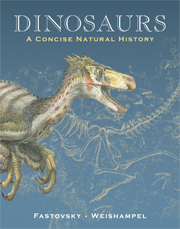Book contents
- Frontmatter
- Contents
- Why a natural history of dinosaurs?
- Dedication
- Part I Reaching back in time
- 1 To catch a dinosaur
- 2 Dinosaur days
- 3 Who's related to whom – and how do we know?
- 4 Who are the dinosaurs?
- Part II Ornithischia: armored, horned, and duck-billed dinosaurs
- Part III Saurischia: meat, might, and magnitude
- Part IV Endothermy, endemism, and extinction
- Glossary
- Figure credits
- Index of subjects
- Index of genera
3 - Who's related to whom – and how do we know?
- Frontmatter
- Contents
- Why a natural history of dinosaurs?
- Dedication
- Part I Reaching back in time
- 1 To catch a dinosaur
- 2 Dinosaur days
- 3 Who's related to whom – and how do we know?
- 4 Who are the dinosaurs?
- Part II Ornithischia: armored, horned, and duck-billed dinosaurs
- Part III Saurischia: meat, might, and magnitude
- Part IV Endothermy, endemism, and extinction
- Glossary
- Figure credits
- Index of subjects
- Index of genera
Summary
Chapter objectives
The goal of this chapter is to get comfortable with the following subjects, because we'll revisit them again and again throughout this book:
Phylogeny
Evolution
Phylogenetic systematics
Cladograms
Logic of science and hypothesis testing
Who are you?
Identity is the fundamental question in all animals – including humans. Knowing who we are provides the essential context for us, and, for this reason, a favorite dramatic technique (think soap operas) is to have a key character lose some aspect of his or her identity. If you think about it, who animals are governs every aspect of their behavior.
“Who are you?” is really the same question as “To whom are you related?” because relationship, as in human families, is the key to identity. So to understand who dinosaurs are, we need to know their relationships – to each other and to other animals.
Those relationships – who we are and where we come from – are the special province of phylogeny: the history of the descent of organisms. And here is where evolution comes in: evolution is the cause of the fundamental genealogical connection among organisms.
Evolution
Evolution refers to descent with modification: the concept that organisms have changed and modified their morphology (morph – shape; ology – the study of) through each succeeding generation (see Appendix 3.1 for a brief refresher on evolution). That makes each new generation the most recent bearer of the unbroken genetic thread that connects life.
- Type
- Chapter
- Information
- DinosaursA Concise Natural History, pp. 32 - 49Publisher: Cambridge University PressPrint publication year: 2009

